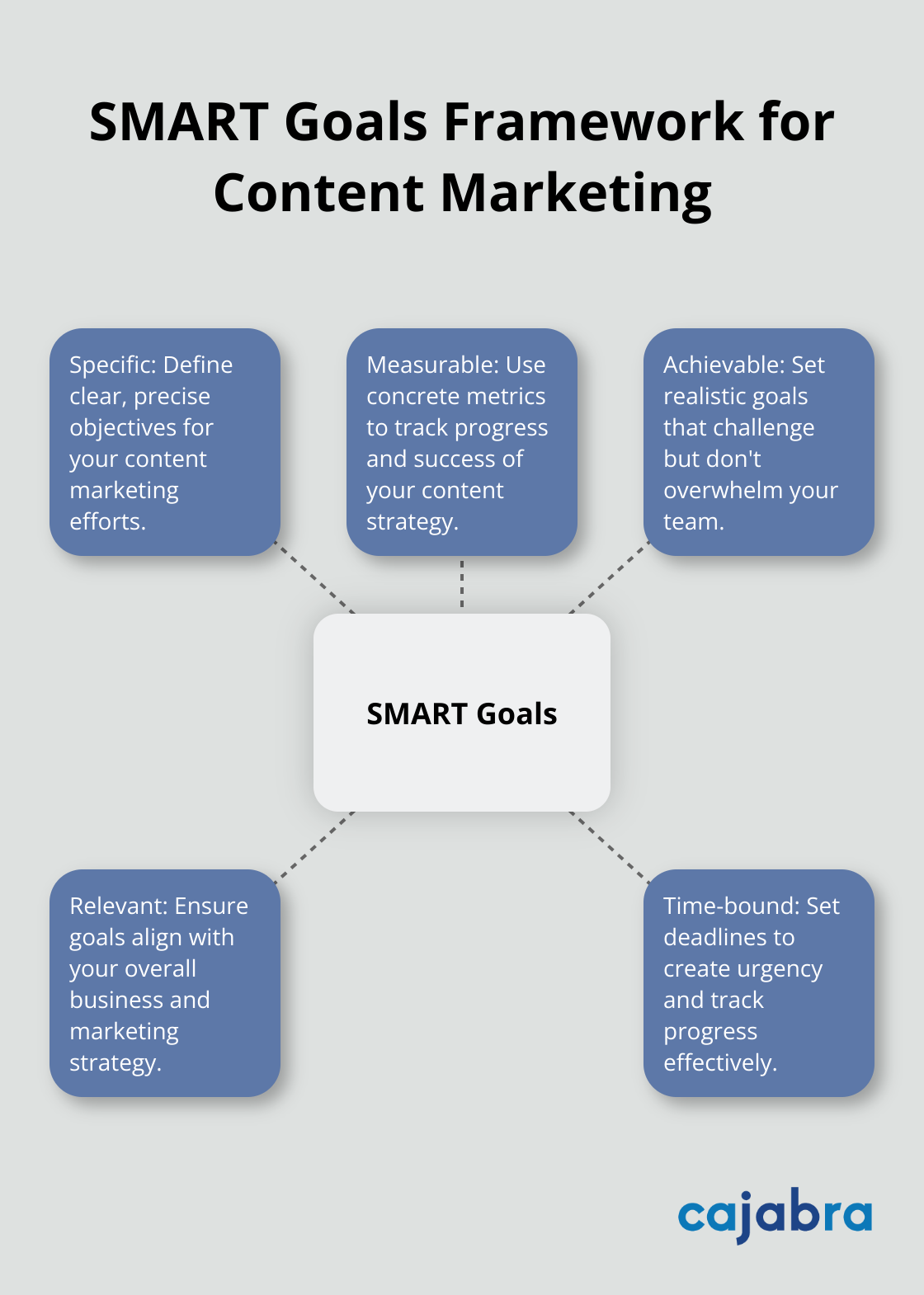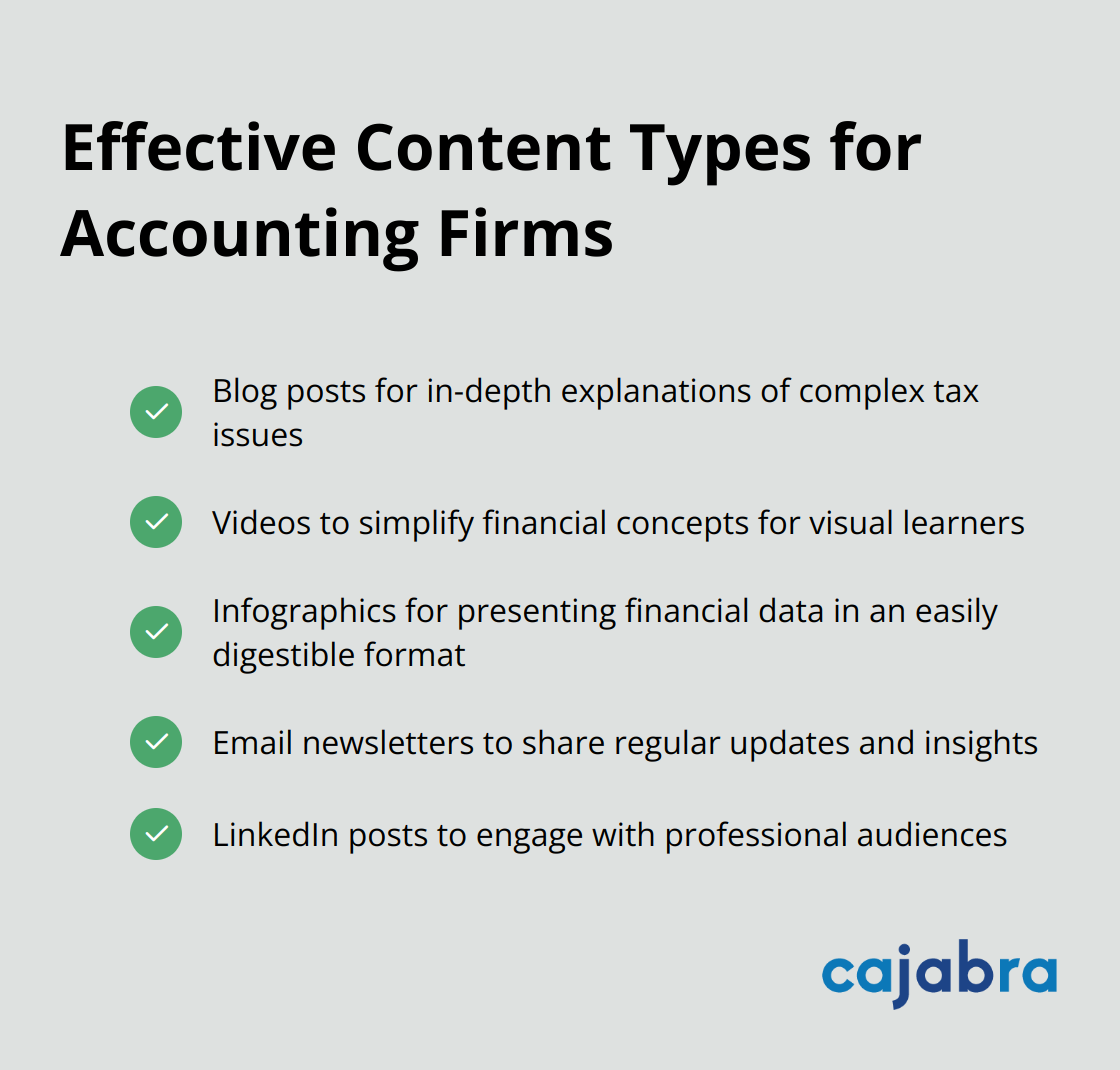
Content marketing is a powerful tool for businesses to attract and engage their target audience. At Cajabra, LLC, we've seen firsthand how a well-crafted strategy can drive results.
In this post, we'll walk you through the steps to create an effective content marketing strategy, complete with practical examples. Whether you're just starting out or looking to refine your approach, these insights will help you develop a plan that delivers real value to your audience and your business.
Content marketing success starts with clear, actionable goals. Many businesses struggle to define exactly what they want to achieve with their content efforts. Let's break down how to set meaningful objectives that drive real results.
Start by examining your overall business goals. Do you want to increase brand awareness, generate more leads, or boost sales of a specific product? Content marketing goals should directly support these broader objectives. For example, if your main business goal is to increase market share in the accounting software sector, your content marketing might focus on educating potential customers about the benefits of your solution compared to competitors.
After identifying your business objectives, translate them into specific content marketing goals. We recommend using the SMART framework:

Specific: Try "increase organic traffic to our accounting software landing page by 25%" instead of "increase website traffic."
Measurable: Use concrete metrics. "Generate 50 new email subscribers per month from our content efforts."
Achievable: Be realistic. If you currently get 100 views per blog post, aiming for 10,000 overnight isn't feasible.
Relevant: Ensure your goals align with your overall strategy. If you focus on retaining existing clients, "go viral on TikTok" might not be the most relevant goal.
Time-bound: Set a deadline. "Increase our blog's conversion rate from 2% to 3% within the next quarter."
Your content marketing goals shouldn't exist in isolation. They need to work in harmony with your broader marketing efforts. If your overall marketing strategy focuses on positioning your firm as a thought leader in tax planning, your content goals might include "Publish two in-depth tax strategy guides per month" and "Secure three guest posting opportunities on respected industry websites each quarter."
Goal-setting is an ongoing process. Regularly review and adjust your objectives based on performance data and changing business needs. This approach allows you to create content with purpose and demonstrate the real value of your content marketing efforts.
With clear goals in place, you're ready to move on to the next critical step: understanding your target audience. Knowing who you're creating content for will shape every aspect of your strategy, from topic selection to distribution channels.
Understanding your target audience is essential for creating content that resonates and drives results. Start by creating comprehensive buyer personas. These are fictional representations of your ideal clients, based on real data and market research. For accounting firms, this might include small business owners, CFOs of mid-sized companies, or high-net-worth individuals seeking tax advice.

To build these personas, gather information on:
For example, a persona for a small business owner might be "Sarah, 35, e-commerce entrepreneur, concerned about cash flow and tax compliance, seeks an accountant who understands online businesses."
Market research provides valuable insights into your audience's needs and preferences. Use a mix of primary and secondary research methods:
Your existing customer data is a goldmine of information. Analyze it to uncover patterns and preferences:
For instance, if your LinkedIn posts about tax-saving strategies consistently outperform other content, it's a clear signal to create more in-depth content on this topic.
Use the insights you've gathered to tailor your content strategy. Create content that addresses specific pain points, answers common questions, and provides value to your target audience. For example, if your research shows that many small business owners struggle with cash flow management, you could create a series of blog posts, infographics, or video tutorials on this topic.
Remember to regularly update your audience research (every 6-12 months) as market conditions and client needs can change. This ongoing process will help you stay relevant and continue to provide value to your audience.
With a deep understanding of your target audience, you're now ready to create a content plan that will effectively reach and engage them. Let's explore how to develop a strategic content plan in the next section.
Your content mix should reflect your audience's preferences and your marketing goals. For accounting firms, a combination of blog posts, videos, and infographics often works well. Blog posts allow for in-depth explanations of complex tax issues, while videos can simplify financial concepts for visual learners. Infographics are excellent for presenting financial data in an easily digestible format.

If your research shows that your target audience prefers visual content, you might focus on creating more video tutorials explaining tax preparation steps or infographics illustrating changes in tax laws.
A content calendar helps maintain consistency and aligns your content with key dates in the financial year. Start by mapping out important events like tax deadlines, financial reporting periods, and industry conferences. Then, plan your content around these dates.
You might schedule a series of blog posts about tax preparation strategies in the months leading up to tax season. Or, you could plan a video series on financial planning to coincide with the start of a new fiscal year.
Efficiency is key in content creation and distribution. Establish clear workflows for each content type. This might involve assigning specific team members to different tasks, setting up review processes, and determining publication schedules.
For distribution, identify the channels where your audience is most active. LinkedIn is often a prime platform for accounting firms, but don't overlook the power of email newsletters or industry-specific forums.
SEO is vital for ensuring your content reaches your target audience. Research your keywords, optimize your onsite SEO, build a website focused on your ideal clients, be wary of plagiarism, and list your contact details.
Optimize your content by including these keywords in titles, headers, and throughout the body of your content. But readability comes first. Don't sacrifice the quality of your content for the sake of keyword stuffing.
The financial landscape changes constantly, and your content should reflect that. Plan to regularly update your evergreen content with the latest information. An article about tax deductions should be reviewed and updated annually to reflect any changes in tax laws.
Repurposing content can also maximize your efforts. Content marketing for accountants involves creating and distributing valuable, relevant content to attract, engage, and retain a clearly defined audience. This content marketing approach can save time and resources while effectively capturing leads and driving conversions.
Creating an effective content marketing strategy requires careful planning, execution, and refinement. Your strategy should adapt to the dynamic financial industry. We recommend you evaluate performance metrics, gather audience feedback, and stay informed about industry trends regularly.
Experiment with different content marketing strategy examples to find what works best for your firm. Try various content types, distribution channels, and messaging approaches. Track your results and focus on what resonates most with your audience.
At Cajabra, we specialize in helping accounting firms attract and retain high-value clients. Our approach (including the JAB System™) positions firms as industry leaders. Explore how we can support your growth and elevate your content marketing efforts today.



